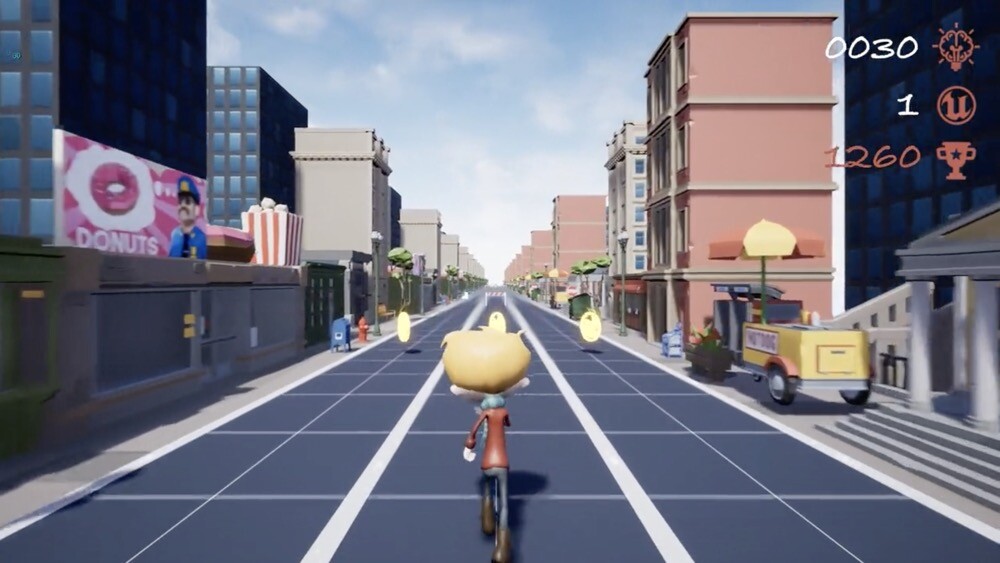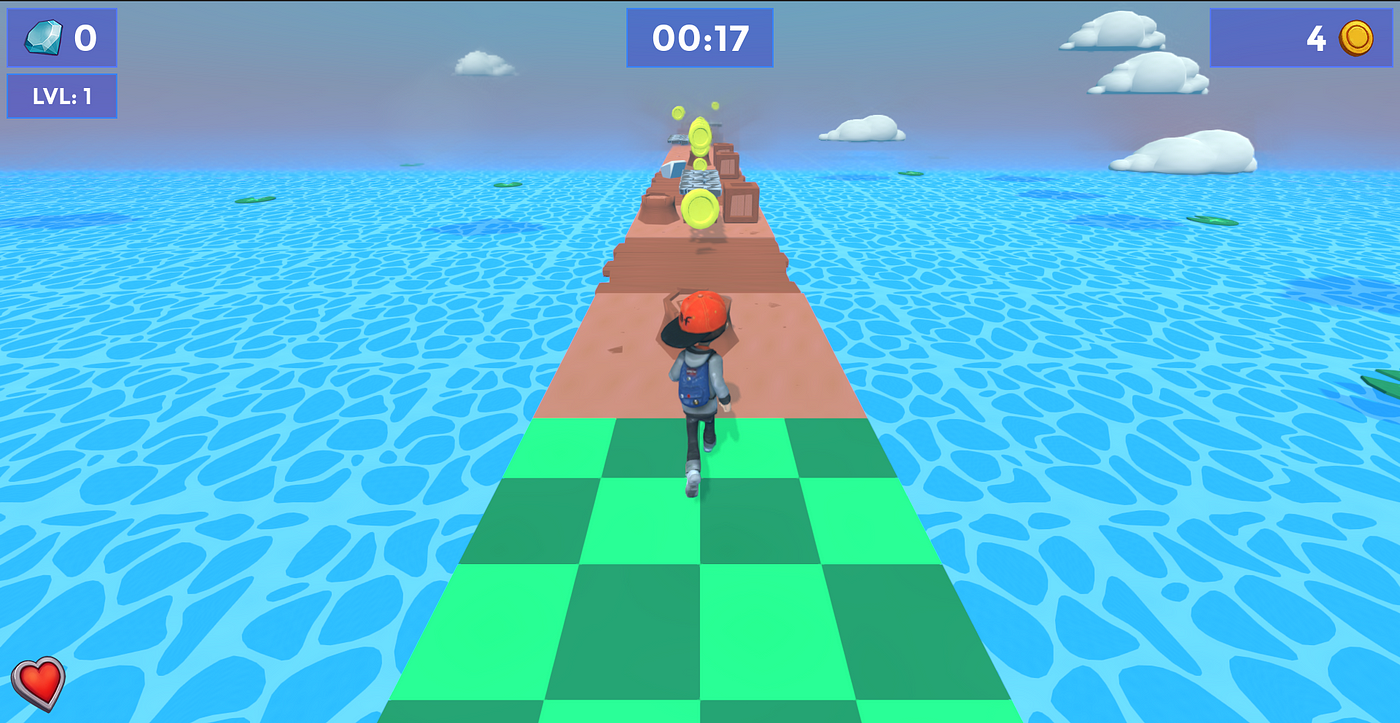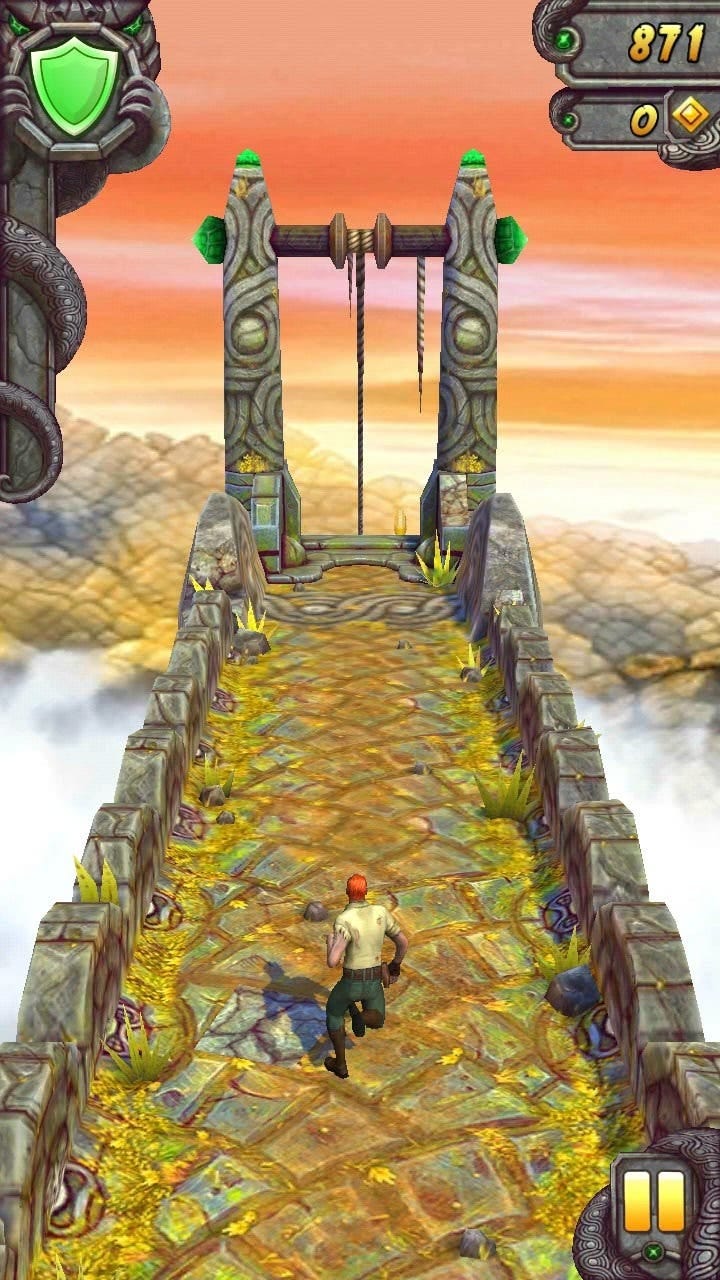Endless runner games are a type of video game where the player character runs endlessly, automatically moving across an ever-scrolling environment. The main objective is to avoid obstacles and survive for as long as possible by jumping, ducking, or taking other evasive actions.
ER games have simple premise but addictive gameplay loops that keep players engaged. The endless levels, constantly moving terrain, and increasing difficulty make for tense, fast-paced experiences perfectly suited for mobile gaming sessions.

While endless runners have roots in classics like Side Park (1958) and Moon Patrol (1982), the genre took off with mobile hits like Canabalt (2009) and Temple Run (2011). Temple Run kicked off an endless runner craze, popularizing the swipe control scheme and generating over 1 billion downloads.
Part of the appeal was the simple pick-up-and-play nature paired with surprising depth. Endless runners were easy to learn but tough to master, with high skill ceilings for maximizing combos and high scores. This gameplay versatility attracted casual and hardcore gamers alike.
The success of Temple Run spawned many imitators like Subway Surfers (2012) which found its own massive audience. Mobile developers gravitated to the genre for its inherent replayability, addictiveness, and monetization potential through in-app purchases.
Subsequent hits like Alto’s Adventure (2015) further refined the runner formula with beautiful art styles and novel twists on obstacles and traversal. The genre’s portability and simple satisfaction made it a continue mobile gaming staple throughout the 2010s and beyond.
Core Mechanics and Gameplay
Endless runner games have some key gameplay elements that define the genre and create their distinctively frantic yet addictive experiences. At their core is the premise of endless levels that automatically scroll forward without any way for the player to stop or slow down.
Endless Levels and Automatic Scrolling
ER games have levels that never end! The character keeps running and running across a scene that moves forward automatically. There are no finish lines or stopping points. The only way to stop is by crashing into something. This endless running across an always-moving level makes the runner game PC feel faster and more exciting. It pushes the player to stay focused and avoid mistakes for as long as possible.
Obstacle Avoidance and Player Actions
As the levels scroll endlessly, obstacles will start appearing that the running character must jump, duck or move around. These could be gaps to leap over, barriers to slide beneath, enemies to dodge left or right, and other hazards everywhere! The obstacles get harder and come more frequently the longer you run. Players only have a few basic moves like tapping to jump or swiping to change lanes. Using these simple actions perfectly is needed to keep clearing the increasingly tricky obstacle courses.
Scoring Systems and Replayability
There is no real way to win an endless runner Javascript game. Instead, the main goal is to get high scores by running as far as you can. Points are earned for distance traveled, collectibles gathered, tricks performed, and staying alive longer. Many games have leaderboards online to compete against other players globally for the best scores. There are also level high scores, achievements, and challenges to complete using different scoring requirements. Trying to top your own and others’ high scores always gives you something new to play for.
Scoring is made even more addictive through progression systems that reward you for earning more points over time. By playing repeatedly, you can unlock new characters with special abilities, visual customization options, extra environments to run through, and more gameplay modes. Getting new rewards by raising your high score gives you constant motivation to replay the same running action again and again.
Simple Controls and Mobile-Friendly Design
The controls in endless runners are very basic to make them pick-up-and-play for anyone. Most just use a single tap to jump or swipe to change lanes. Some games even take out all control beyond just swiping directions! Having only one or two simple moves to learn makes the games extremely accessible. Despite their simplicity, the controls still allow skilled players to get far by mastering the timing and execution needed for high scores.
These basic tap and swipe controls work perfectly for mobile devices like phones and tablets where the games are hugely popular. The quick playstyle of trying to go as far as possible in a short burst is ideal for short gaming sessions on the go. And because runs are measured in high scores instead of long-term progression, mobile players can enjoy a full, satisfying experience whenever they have a few spare minutes.
ERs also make great use of mobile hardware with immersive 3D graphics and environments filled with impressive details and effects. While the core gameplay stays simple, developers put a huge focus on audio and visual quality to make the perpetual running more engaging and fun to experience.
Some other cool popular endless runner games online include:
- Subway Surfers
- Temple Run 1 & 2
- Alto’s Adventure
- Alto’s Odyssey
- Sonic Dash
- Jetpack Joyride
- Pou
- Minion Rush
- Spider-Man Unlimited
- Dragon Flight
- Snowboard Party
- Run Race 3D
- Sky Force Reloaded
- Badland
- Noodlecake Studios Games (Super Stickman Golf, Zombie Road Trip)
- Crossy Road
- Flappy Bird
- Skyline Skaters
- Beach Buggy Racing
- Stampede Run
- Endless Road
- Smash Champs
- Rail Rush
- Super Bunny Monde
- Cube Runner Adventure.
Endless runners continue to be a hugely popular mobile game genre with modern hits like Data Wing, Wu Xing: The Code, and Super Bunny Streak joining the classics. Their simple “endless” gameplay with tap/swipe controls make them perfect for pick-up-and-play sessions on phones and tablets.
From starting as quick time-wasters to becoming some of the most popular mobile games today, endless runners have found massive success by perfecting easy-to-learn but hard-to-master mechanics focused on endless levels, skillful obstacle avoidance, scoring systems with endless replayability, and minimalist controls built for mobile’s tap and swipe inputs. By keeping these core gameplay pillars simple yet satisfying, the ER remains an enduringly addictive way for players to perpetually chase just one more high score.
50 Endless Runner Game Genres
Endless runner games have become a popular genre in the world of mobile and browser-based gaming, offering a simple yet addictive gameplay experience. These games typically involve a character running endlessly through a never-ending environment, with the objective being to survive for as long as possible while avoiding obstacles and collecting power-ups. The keywords provided cover a wide range of endless runner games, each with its own unique twist.
1. Tomb Runner: This game takes inspiration from the popular “Tomb Raider” series, adding an endless running element to the classic platformer gameplay. Players navigate through ancient ruins, dodging traps and obstacles while collecting valuable artifacts.
2. JavaScript Runner: These games are built using JavaScript, a programming language that allows for seamless integration into web browsers. Examples include the iconic “Dino Runner” game, which can be played on Google Chrome when the internet connection is lost.
3. Cube Runner: In this genre, the character navigates through a world made up of cubes, often featuring minimalistic graphics and challenging obstacles.
4. Ghost Runner: These games typically feature a ghostly or ethereal character running through haunted environments, dodging supernatural obstacles and collecting spectral power-ups.
5. Speed Runner: As the name suggests, these games emphasize speed and agility, challenging players to navigate through fast-paced environments while avoiding obstacles and performing precise movements.
6. Running Dinosaur Game: Popularized by the “Dino Runner” game on Google Chrome, these games feature a pixelated dinosaur character running through a prehistoric landscape, jumping over obstacles and collecting power-ups.
7. Runner Games Online: Many endless runner games are designed to be played online, either through web browsers or on dedicated gaming platforms, allowing for easy accessibility and multiplayer experiences.
8. Bit Trip Runner: This game combines elements of endless running with rhythm-based gameplay, challenging players to navigate through a stylized, retro-inspired world while staying in sync with the beat.
9. Bull Runner Game: In these games, players take control of a character running from a rampaging bull, dodging obstacles and collecting power-ups along the way.
10. Free Runner: These titles often feature a parkour-inspired gameplay, where players navigate through urban environments, jumping over obstacles and performing acrobatic moves.
11. Game Maze Runner: These games combine the endless running concept with maze-like environments, requiring players to navigate through complex labyrinths while avoiding obstacles and collecting power-ups.
12. Wave Runner Mega Ball: Players control a ball-like character surfing or running along waves, potentially with an aquatic or beach-themed environment.
13. Google Dinosaur Runner: The iconic “Dino Runner” game that appears on Google Chrome when there is no internet connection, offering a simple yet addictive gameplay experience.
14. Vector Runner Game: A game featuring vector graphic-style visuals for the endless running environments and characters.
15. Twerk Runner: A unique and potentially humorous game where the character’s running animation resembles twerking.
16. Mario Runner: Inspired by the beloved Super Mario franchise, these games feature the iconic plumber running through iconic environments from the Mario universe.
17. Ninja Runner: Featuring a stealthy ninja character, these games challenge players to navigate through treacherous environments while performing acrobatic moves and avoiding deadly obstacles.
18. Red Tie Runner: These games often feature a character in business attire, running through office-inspired environments while dodging obstacles and collecting power-ups.
19. Run Games 3: The third iteration of a popular endless runner game series, often featuring updated graphics, new environments, and additional challenges.
20. Runner 3 Online: The third installment of a popular endless runner game series, designed to be played online, either through web browsers or dedicated gaming platforms.
21. Runner Cool Math Games: These games are often found on educational websites or platforms, combining endless running gameplay with educational elements or math-based challenges.
22. Wind Runner Game: The character’s running is likely affected by wind physics, requiring players to account for gusts or air currents.
23. Snow Runner Game: Set in a winter wonderland, these games challenge players to navigate through snowy environments, dodging obstacles and collecting power-ups while battling the elements.
24. Space Runner: Taking the endless running concept to the cosmos, these games feature characters running through outer space environments, dodging asteroids, and navigating through alien landscapes.
25. Sprint Runner Games: Emphasizing speed and agility, these games challenge players to run as fast as possible while avoiding obstacles and collecting power-ups.
26. Zombicide Runners: An endless runner spin-off or tie-in to the popular “Zombicide” board game series, likely featuring zombie-themed obstacles and environments.
27. Stickman Runner: Featuring a simple stickman character, these games offer a minimalistic yet challenging endless running experience, often with quirky or humorous elements.
28. Tales Runner: Combining elements of storytelling with endless running gameplay, these games often feature rich narratives and characters inspired by various tales or mythologies.
29. Game Runner: A broad category encompassing various endless running games, each with its own unique twist or gameplay mechanic.
30. Cat Runner: Featuring a feline protagonist, these games challenge players to navigate through cat-themed environments, dodging obstacles and collecting power-ups.
31. JavaScript Code Runner: These games are built using JavaScript code, allowing for seamless integration into web browsers and providing a platform for developers to showcase their coding skills.
32. Blob Runner 3D: Taking the endless running concept into the third dimension, these games feature a blob-like character navigating through 3D environments, dodging obstacles and collecting power-ups.
33. JavaScript Runner Online: Similar to “JavaScript Runner,” these games are built using JavaScript and designed to be played online, either through web browsers or dedicated gaming platforms.
34. Snow Runner PC: A version of the “Snow Runner” game designed for PC platforms, offering enhanced graphics and gameplay experiences.
35. Dinosaur Runners: A category of games featuring various dinosaur characters as the protagonists, running through prehistoric environments and dodging obstacles.
36. Gravity Runner: These games introduce unique gravity mechanics, challenging players to navigate through environments with varying gravity conditions, adding an extra layer of challenge to the gameplay.
37. 3D Runner Game: Taking the endless running concept into the third dimension, these games offer immersive 3D environments and obstacles to navigate through.
38. Alien Runner Game: Set in extraterrestrial environments, these games feature alien characters or protagonists running through otherworldly landscapes, dodging obstacles and collecting power-ups.
39. Animal Race Games: Featuring various animal characters as protagonists, these games challenge players to navigate through animal-themed environments while competing against other virtual racers.
40. Atomic Runner: These games often feature a post-apocalyptic or nuclear-themed setting, with players running through irradiated environments while dodging radioactive obstacles and collecting power-ups.
41. Truth Runner Game: The original game that “Truth Runner 2” is a sequel to, also likely incorporating truth/deception themes.
42. Truck Runner Game: These games task players with running alongside or evading large trucks or other vehicles on highways or city streets.
43. Blob Runner: Featuring a blob-like character as the protagonist, these games offer a unique and quirky endless running experience, often with whimsical or surreal environments.
44. Tower Runner Game: Players run vertically up or around towers, dodging obstacles and collecting power-ups as they ascend higher and higher.
45. Canabalt Game: The original “Canabalt” game, which became a landmark in the endless runner genre and inspired countless other games.
46. Totem Runner: These games likely feature totem pole-inspired obstacles or elements that players must navigate through or collect as they run endlessly.
47. Chrome Dino Runner: The iconic “Dino Runner” game found on Google Chrome, featuring a pixelated dinosaur character running through a prehistoric landscape.
48. Corridor Z: A unique endless runner game set in a zombie-infested environment, where players must navigate through narrow corridors while avoiding the undead.
49. Crash Bandicoot Runner: A spin-off of the popular “Crash Bandicoot” platformer series, featuring the iconic marsupial protagonist running through various environments and dodging obstacles.
50. Train Runner Game: Players run endlessly along or across train tracks, dodging oncoming trains and other rail-related hazards.
Notable Examples and Success Stories
Many endless runner games became very popular hits. The most successful ones had special ideas that made their games fun and different.
Temple Run
One of the biggest hits that kicked off the endless runner craze was Temple Run. Released in 2011 for mobile devices, the run mobile game had players take control of an explorer character running endlessly to escape an evil monster. The simple swipe controls to turn left, right, jump and slide made it extremely easy to pick up and play.
Temple Run’s biggest innovation was monetizing the endless format through lives and power-ups sold via in-app purchases. Players who ran out of lives could opt to wait or pay to replenish them instantly and keep running. This model proved immensely profitable, generating over $1 billion in revenues for developer Imangi Studios through microtransactions. Temple Run’s massive success sparked an avalanche of copycat games in the same mold.
Subway Surfers
Following in Temple Run’s footsteps, Subway Surfers by Kiloo and SYBO Games became another endless runner mega-hit in 2012. In this game, players took control of a hoodie-wearing graffiti artist endlessly running away from an angry inspector and his dog across a procedurally generated subway railway.
A key reason for Subway Surfers’ wild popularity was its frequent updates adding new environments inspired by real-world cities like New York, Paris and Tokyo. These visually fresh settings and character customizations helped drive over 3 billion downloads across mobile platforms. Subway Surfers demonstrated the incredible player engagement possible by continually delivering new content within the simple endless runner formula.
Alto’s Adventure
While earlier hits showcased the profit potential of endless runners, Alto’s Adventure demonstrated the genre’s capacity for artistry in 2015. Featuring a minimalist but gorgeous desert setting rendered in a striking visual style, players controlled a llama herdsman endlessly snowboarding down procedurally generated mountains.
In addition to its beautiful aesthetics, Alto’s Adventure introduced nuances like catching air and performing tricks off jumps and grinding across cables. This added depth beyond just dodging obstacles made high score chasing more involved. Combined with a soothing soundtrack, Alto proved endless runners could be serene yet compelling experiences.
Jetpack Joyride
While most endless runners stick to side scrolling perspectives, Jetpack Joyride by Halfbrick Studios took a more vertical approach when it launched in 2011. In this title, players controlled the heroic Barry Steakfries propelling endlessly upwards by activating a jetpack, avoiding obstacles like missiles and electric forcefields.
Jetpack Joyride distinguished itself with an extensive metagame of unlockable gadgets and vehicle power-ups that dramatically altered gameplay. It exemplified how endless runners could stay fresh via meaningful upgrades beyond just visual trinkets or score modifiers. The 2d runner game was a critical and commercial success that spurred Halfbrick to create many sequels and spinoffs.
Other Popular ER Titles and Unique Features
The endless runner craze spawned many other hit games across the 2010s on mobile. Titles like Run Rich 3D and Fun Run applied the frantic auto-running gameplay to fun multiplayer racers. Games like Minion Rush and Sonic Dash let players control popular characters from major franchises like Despicable Me and Sonic the Hedgehog.
Some endless runners experimented with novel control schemes like Crossy Road’s simple taps to hop in any direction. Others blended in RPG progression like Blades of Brim or ragdoll physics like Action Henk. While sticking to the core of endless levels and high score chasing, these releases constantly introduced new gameplay hooks to keep the genre feeling fresh and unbounded in its creative potential.
| Game | Year | Developer | Unique Idea/Hook |
| Temple Run | 2011 | Imangi Studios | One of the first big hits, monetized through lives/powerups |
| Subway Surfers | 2012 | Kiloo, SYBO Games | Frequently updated with new environments based on real cities |
| Alto’s Adventure | 2015 | Team Alto | Artistic visual style, tricks like catching air and grinding |
| Jetpack Joyride | 2011 | Halfbrick Studios | Vertical scrolling gameplay, upgradeable vehicles and gadgets |
| Crossy Road | 2014 | Hipster Whale | Tap to hop in any direction, colorful voxel art style |
| Minion Rush | 2013 | Gameloft | Featured Minions from the Despicable Me movies |
| Sonic Dash | 2013 | SEGA | Starred Sonic the Hedgehog in an endless runner |
| Run Rich 3D | 2015 | Funful Games | Multiplayer racing against other players |
| Fun Run | 2011 | DirtyBit | Colorful multiplayer racing with customizable characters |
| Blades of Brim | 2012 | Subatomic Studios | Combined endless running with RPG progression and loot |
| Action Henk | 2014 | RageSquid | Ragdoll physics gameplay with over-the-top animations |
| Canabalt | 2009 | Semi Secret Software | One of the earliest endless runners that kickstarted the genre |
No matter how they innovated, all these successful endless runner titles capitalized on the simple premise’s instantly graspable fun while layering in just enough novel hooks to compel players to chase new high scores again and again. By nailing this delicate balance, endless runners like Temple Run, Subway Surfers, Alto’s Adventure and Jetpack Joyride turned a seemingly niche mobile gaming concept into a multi-billion dollar global phenomenon beloved by casual and hardcore gamers alike for their pure “just one more try” addictiveness.
ER Appeal and Accessibility
The best runner games are extremely appealing and accessible to many people. This is because they are easy to pick up and play casually.
ER Casual and Pick-Up-and-Play Nature
One big reason endless runner games are so popular is how casual and easy they are to pick up and play. The core gameplay of just endlessly running and dodging things is very simple to understand. The controls are also extremely basic, usually just tapping to jump or swiping to move. Even total beginner game runners can start playing right away without much instruction.
The casual, straightforward nature makes endless runners perfect for short bursts of gaming whenever you have a few spare minutes. Since the games have no real endings, you can play for as little or as long as you want in a single session. This pick-up-and-play style fits well for killing time during commutes, waiting in lines, or any other situations with pockets of free time.
Despite their simplicity, endless runners still offer enough depth through high score chasing and unlocks to keep people playing for years. The easy-to-learn but hard-to-master gameplay means both casual gamers and hardcore fans can find enjoyment from the same endless running experiences.
Broad Audience Appeal
The accessibility and simple joy of endless running has given the genre incredibly broad appeal across:
- Non-gamers and newcomers to the hobby, providing an easy entry point without complicated controls or concepts.
- Kids, who can instantly understand the gameplay of dodging obstacles by jumping and sliding.
- Hardcore gamers, drawn to the skill-based high score gameplay and procedurally generated (proc-gen) levels requiring intense focus and finely-tuned reflexes.
- Perfectionists and completionists, who get satisfaction from earning new personal best scores.
- Competitive players who enjoy climbing online leaderboards against the entire world’s talent pool.
- Older/classic gamers who can relate to the simplicity and scoring systems reminiscent of vintage arcade games.
- Younger/mobile gamers are attracted by the vibrant visuals, short sessions perfect for smartphones, and constant stream of unlockables and rewards to earn.
Endless runners have truly become universally appealing by transcending interests, skill levels, age groups and demographics through pure gameplay fun.
Free-to-Play and Monetization Models
A major factor in endless runners’ wide accessibility is how most operate as free-to-play games. By allowing unlimited free access to the core running gameplay, developers have lowered the barrier to entry so anyone can try a game without paying upfront.
The free access model has proven immensely successful for proliferating endless runner hits to massive global audiences. Once hooked on the addictive high score loops, players can then optionally spend money on unlocking bonuses like new characters, powerups, items, or level skips to enhance their progression.
Many games sell lives or revives to recover from failed runs immediately rather than waiting for a reset timer. This creates a strong monetization incentive while still allowing full free-to-play enjoyment for patient players happy to run again later.
Ads provide another popular revenue stream for endless runners by allowing uninterrupted free play for those willing to watch short advertisements periodically. Games may reward players with lives or currency boosts for voluntarily viewing ads.
Some games strike a balance by offering an upfront paid option to permanently remove ads and monetize from players preferring a premium experience with no microtransactions or interruptions. Those unable to pay can still access the full game for free in this hybrid approach.
No matter which specific model is used, endless runners have democratized gaming by making their highly replayable gameplay freely accessible while still generating revenues through optional purchases and unintrusive advertising. This flexibility has allowed the genre to amass gigantic user bases of both free and paying players across all demographics.
Overall, endless runners have found massive mainstream success by perfecting intuitive gameplay that absolutely anyone can instantly understand and enjoy in short bursts or extended high score quests. By removing as many barriers to picking up and playing as possible through simple controls, free access, and smartly integrated monetization options, the endless runner has cultivated an incredibly broad and diverse audience of players from all walks of life united by the pure fun of endlessly running.
Design Challenges and Considerations
Making never-ending levels is hard. Developers must create levels that go on forever without things repeating over and over. This is called procedural generation.
They need many different obstacles like holes to jump, barriers to slide under, bad guys to avoid, and dangers everywhere. These obstacles must appear in random orders so each run feels new and unpredictable. Too many repeats will make players bored.
But the obstacles also need some rules and structure. Having totally randomness is just messy and confusing. There should be set patterns of obstacles that get harder over time and distance.
Finding this balanced randomness while still controlling the patterns and increasing difficulty is the big challenge of endless level design.
Balancing Difficulty and Progression
Endless runner games always get harder the longer you play. But making it too hard too fast will frustrate new players who can’t improve their skills that quickly.
Developers must carefully plan how much more obstacles appear over time. Going too fast will cause many rage quits. Going too slow will bore better players to quit.
The difficulty curve must increase at a good pace to challenge players of all skill levels based on their current abilities without overwhelming them.
Maintaining Player Engagement
Even perfect levels can’t sustain endless runners forever alone. Players will eventually get tired of the same experience without new updates.
Developers must keep providing new content like environments, gameplay modes, unlockables, customizations and other fresh reasons to keep playing.
Limited-time events, holidays, new goals and other rotating content helps endless runners avoid going stale. It gives players exciting new things to look forward to.
Unlocking new characters, powers, visuals are also big drivers that reward players for sticking with the endless gameplay grind.
Some endless runners now have stories with characters on quests to follow along with mysteries. This provides purpose beyond just scoring.
Implementing Rewarding Progression
Endless runner progression is primarily about unlocking upgrades, new abilities over time through scoring achievements or purchases.
Premium purchases accelerate progression but cannot make the game too easy. Finding players get huge free advantages reduces competition and incentives to commit.
The best progression rewards players’ time investments through earned enhancements that steadily increase their enjoyment without undermining the true scoring challenge and competition.
Good rewards add meaningful power-ups, new strategies, different environments, or just fun visual changes that don’t directly impact scoring abilities.
Well-designed progression systems establish motivating short-term and long-term goals. Short goals like level milestones provide quick rewards to stay engaged. Long-term goals like cumulative scoring or big purchases provide longevity.
Endless runners constantly give players clear objectives beyond just scoring alone while respecting the core high score gameplay.
Many also motivate through social features like leaderboards, video replays, co-op/versus modes. This enables community competition and status rewards.
Future Trends and Innovations
As technology continues to advance, endless runner games are likely to evolve and incorporate new features and innovations. One potential trend is the integration of virtual reality (VR) or augmented reality (AR) elements into the genre. Imagine running through a virtual world, physically dodging obstacles and collecting power-ups in a fully immersive experience.
Another area of potential innovation is the use of procedural generation. By dynamically generating the level layout and obstacles, each playthrough can offer a unique and unpredictable experience. This approach would further enhance the replayability and longevity of endless runner games.
Furthermore, advancements in artificial intelligence (AI) could be utilized to create more intelligent and challenging obstacle patterns. AI-controlled obstacles could adapt to the player’s skills and strategies, offering a more personalized and engaging experience.
Lastly, social integration and multiplayer features could be further explored in endless runner games. Cooperative or competitive multiplayer modes would allow players to team up or compete against each other, adding a new layer of excitement and social interaction.
Conclusion
Endless runner games have become a staple in the mobile gaming industry, captivating players with their addictive gameplay loops and accessible mechanics. From the success of Temple Run to the popularity of Subway Surfers and the artistic beauty of Alto’s Adventure, the genre continues to evolve and innovate.
With their simple yet challenging gameplay, endless runners offer an immersive and exciting experience for players of all ages. The future holds promising advancements, such as VR integration, procedural generation, and AI-driven obstacles, further pushing the boundaries of the genre.
Whether you’re looking for a quick gaming fix or a competitive challenge, endless runner games are sure to deliver endless hours of entertainment. eJaw game development company knows everything about this trend. Contact us to know more.












